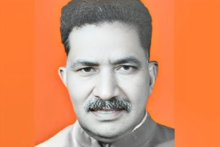| K. K. Nair | |
|---|---|
 | |
| Born | Karunakaran Pillai 11 September 1907 Quilon, Travancore (present-day Kuttanad, Alappuzha, Kerala) |
| Died | 7 September 1977 |
Kadangalathil Karunakaran Nayar or K. K. Nayar or K. K. Nair (born as Karunakaran Pillai, 11 September 1907 — 7 September 1977) was an Indian Bureaucrat and politician who was a member of the Lok Sabha. He played a crucial role in Ayodhya Ram Janmabhoomi dispute.
Personal life
Mr. Nayar was born as Karunakaran Pillai, one of the six children of Kandamkalathil Sankara Panicker and Parvathy Amma at Central Travancore ( present-day Kuttanad, Kerala ) in 1907. His original name was Karunakaran Pillai, also known as Karunakaran Nair. 'Pillai' is a title of nobility in Travancore, while 'Nair' indicates his caste, Nairs interchangeably use both surnames. He completed his early education from Sanatana Dharma Vidyashala, Alleppey, SMV High School, Thiruvananthapuram, University College Thiruvananthapuram (then under University of Madras) Barah Saini College, Aligarh (Agra University)(1954-56) and University College London (1928-30).
He was married to Sarasamma from Thiruvananthapuram after his studies and had a son named Sudhakaran. On his posting to United Provinces they divorced. Later he remarried to Shakuntala Nayar from a Kshatriya family, native of Uttar Pradesh in April 1946 and have a child named Marthanda Vikraman Nair.
Public Career
He joined Indian Civil Service in 1930 and served in various positions in Uttar Pradesh including Gonda (1946), Faizabad (1 June 1949 - 14 March 1950). He was the District magistrate having control over Ayodhya when Ram lalla idol was found inside Babri Masjid in 1949. He took voluntary retirement from service in 1952 and practiced law at the Allahabad High Court. Thereafter he joined Bharatiya Jana Sangh and was a member of Uttar Pradesh Legislative Assembly from 1965-67. He got elected to 4th Lok Sabha from Bahraich (Lok Sabha constituency) as a candidate of Bharatiya Jan Sangh.
See also
References
- "Nair 'saab', the Faizabad District Magistrate who defied Nehru's directive in 1949 to remove Ram Lalla idol". The Indian Express. 21 January 2024. Retrieved 3 May 2024.
- "Nair 'saab', the Faizabad District Magistrate who defied Nehru's directive in 1949 to remove Ram Lalla idol". The Indian Express. 21 January 2024. Retrieved 3 May 2024.
- India. Parliament. Lok Sabha (2003). Indian Parliamentary Companion: Who's who of Members of Lok Sabha. Lok Sabha Secretariat. p. 861.
- ^ "City of 'New Delhi' was named on Dec 31, 1926". The Economic Times. 15 March 2015. ISSN 0013-0389. Retrieved 25 January 2024.
- ^ "Nair 'saab', the Faizabad District Magistrate who defied Nehru's directive in 1949 to remove Ram Lalla idol". The Indian Express. 21 January 2024. Retrieved 25 January 2024.
- "Memorial for Malayali ICS officer KK Nair in Ayodhya temple premises". English.Mathrubhumi. 18 January 2024. Retrieved 25 January 2024.
- Service, Express News (22 January 2024). "Ayodhya cherishes Malayali civil servant who defied Nehru's order to remove Ram Lalla idol". The New Indian Express. Retrieved 25 January 2024.
- Raghunath, Arjun. "Ex-Malayali bureaucrat widely remembered as Ayodhya Ram temple becomes reality". Deccan Herald. Retrieved 25 January 2024.
- "Members Bioprofile". 164.100.47.132. 11 September 1907. Archived from the original on 26 April 2014. Retrieved 26 April 2014.
- "Ram Mandir: From Nayar to Nripendra, a tale of two IAS officers in Ayodhya". The Economic Times. 21 January 2024. ISSN 0013-0389. Retrieved 25 January 2024.
This article about an Uttar Pradesh politician is a stub. You can help Misplaced Pages by expanding it. |